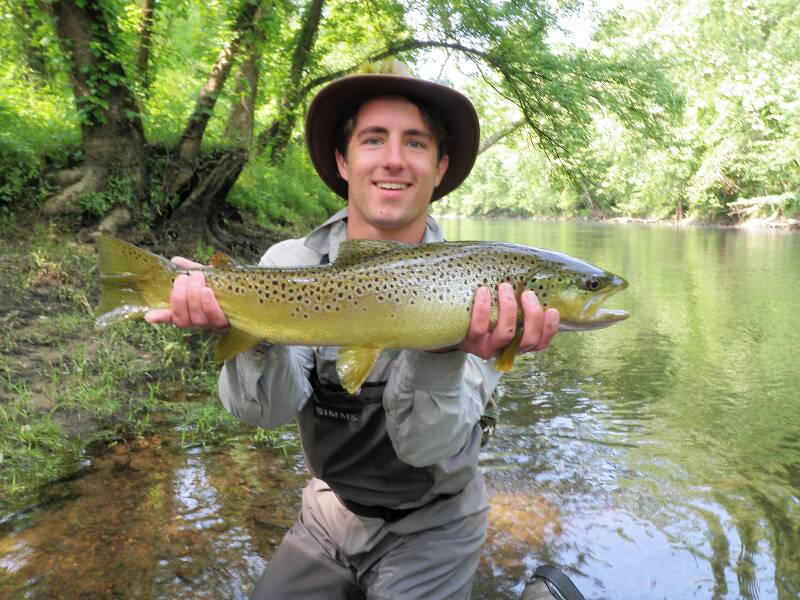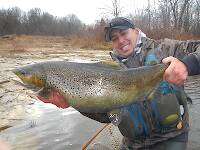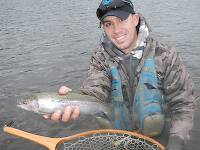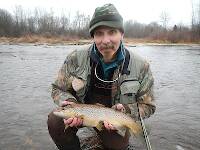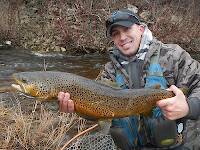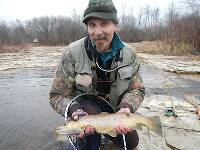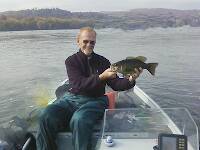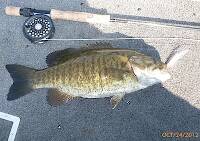
Blue-winged Olives
Baetis
Tiny Baetis mayflies are perhaps the most commonly encountered and imitated by anglers on all American trout streams due to their great abundance, widespread distribution, and trout-friendly emergence habits.
Featured on the forum

This one pretty clearly keys to Kogotus, but it also looks fairly different from specimens I caught in the same creek about a month later in the year. With only one species of the genus known in Washington, I'm not sure about the answer to this ID.

Troutnut is a project started in 2003 by salmonid ecologist Jason "Troutnut" Neuswanger to help anglers and
fly tyers unabashedly embrace the entomological side of the sport. Learn more about Troutnut or
support the project for an enhanced experience here.
PaulRoberts on Nov 24, 2010November 24th, 2010, 3:27 am EST
Surely I would have been shunned, if not down right banished, by my fellow elitists.
Elitists end up limited, even stunted, if not by design at the outset, by practice.
Following RleeP's lead:
Egg flies are one good visible choice for steelies and residents, but nymphs of all types worked too. I often started with an egg pattern, then went back through with a large nymph or flymph and picked up more fish. If there were lotsa other anglers on stream (with the inevitable glowing balls) I might go immediately to fl/nymphs. As Lani Waller put it: "If you can't be first, be different." I have some favorite patterns but won't bore you with them -any creation can work. Wets and streamer flies can work but require really good control to fish them slow enough -dead-drift worked better below 40, in large part bc fish tended to be in the deepest parts of runs and pools under viscous/dense water and it's darn tough to present well with fly tackle then. The issue it seemed is that you are harder pressed to get fish to cross current.
The water temperature thing is very true, and while I agree with the numbers, trends matter too. Dropping temps are toughest, rising temps tend to spark fish. The upper 30s -if the daily peak -can bring surprisingly aggressive fish. It's subtle -when compared to warm water activity. But a rise to 36-38 from the low of 33 can spark activity. Also, fish acclimate under stable conditions and the first light bite, even under super-cooled conditions, can be great. Don't stay home bc of several days of single digits. If there is open water over those fish -GO! With rising temps, don't count out anything (within reason). While they tend to hold in slow water then, they may take ANY presentation. Agreed that you are harder pressed to get fish to cross current, but they may. We fished hardware as well as flies and more "aggressive" pres. worked too -plugs, spinners too -fished slow, or held in place. Interestingly, it was not uncommon for steelies come vertically up from the bottom to smack and vibrating plug, but seem unwilling to cross current. Bc condtions were so cold I never tried hanging big streamers bc fly-line carries too much water and freezes. My cutoff for fly-line was a balmy 27F air temp. With mono rigs, I'd pop yarn flies in my mouth to thaw them between drifts!
About the time I left steelheading, I started to suspect that season mattered too, in that spring fish were less bothered by temp drops than late fall/early winter fish. I suspected it was due to 'bow strain -spring fish more apt to be of saltwater ancestry. But I've seen this, I think, with resident trout too which makes me think that acclimitization is a factor. Acclimation is a short term biochemical adjustment to water temp, acclimitization is a longer term adjustment. If anyone has similar, or different, observations, I'd love to hear about them.
RleeP on Nov 24, 2010November 24th, 2010, 3:59 am EST
>>and while I agree with the numbers, trends matter too.>>
Absolutely and I'm glad you introduced that proviso into the conversation, Paul. Setting steelhead aside momentarily, I can't count the number of times I've been fishing for plain old trout and seen the fish come to life in response to rising water temperatures, even when the maximum temp reached is still pretty numbing (as in fairly rapid rise from 34 to 39 or 40).
This phenomenon can be particularly applicable on the shale substrate streams characteristic of the Lake Erie tribs of NY/PA/OH when there is no snow cover on to melt and depress water temps. In its more open sections with a southern exposure on a bright December day, I've seem Walnut Creek go from 34F at 8AM to 42F at 2PM, even when the air temp barely makes it to freezing, if it even makes it that high. The low groundwater recharge nature of these watersheds and the shale substrate cause them to be highly variable water temp. wise..
Absolutely and I'm glad you introduced that proviso into the conversation, Paul. Setting steelhead aside momentarily, I can't count the number of times I've been fishing for plain old trout and seen the fish come to life in response to rising water temperatures, even when the maximum temp reached is still pretty numbing (as in fairly rapid rise from 34 to 39 or 40).
This phenomenon can be particularly applicable on the shale substrate streams characteristic of the Lake Erie tribs of NY/PA/OH when there is no snow cover on to melt and depress water temps. In its more open sections with a southern exposure on a bright December day, I've seem Walnut Creek go from 34F at 8AM to 42F at 2PM, even when the air temp barely makes it to freezing, if it even makes it that high. The low groundwater recharge nature of these watersheds and the shale substrate cause them to be highly variable water temp. wise..
RleeP on Nov 24, 2010November 24th, 2010, 4:11 am EST
Some pretty interesting stuff there Paul about cold water and air temps. It got me thinking about what was one one my favorite techniques on the PA tribs back when I was a younger guy and was convinced I was bulletproof/invulnerable.
I'd go in January and find a smaller pool that I pretty much knew the lay of in terms of depth and drop offs and the like. Despite being bulletproof and invulnerable, I didn't really want to pick the wrong pool and go arse over tipcup and get soaked... Almost always, these places were froze over at this time of year. So, I'd wade in there with my 5mm Cabelas neoprenes and bust the as much of ice out as I could by wading through it. Then, I'd go sit on the bank for 10 minutes and work on a cigar while the ice floated away. Then, I'd get up and fish my new ice free pool. I caught a lot of fish this way.
I've always been of the view that if there were SAT tests for Lake Erie steelhead, most of them would have to go to early Summer term to prove they were capable and worthy of admission for the full Fall term...:)
I'd go in January and find a smaller pool that I pretty much knew the lay of in terms of depth and drop offs and the like. Despite being bulletproof and invulnerable, I didn't really want to pick the wrong pool and go arse over tipcup and get soaked... Almost always, these places were froze over at this time of year. So, I'd wade in there with my 5mm Cabelas neoprenes and bust the as much of ice out as I could by wading through it. Then, I'd go sit on the bank for 10 minutes and work on a cigar while the ice floated away. Then, I'd get up and fish my new ice free pool. I caught a lot of fish this way.
I've always been of the view that if there were SAT tests for Lake Erie steelhead, most of them would have to go to early Summer term to prove they were capable and worthy of admission for the full Fall term...:)
PaulRoberts on Nov 24, 2010November 24th, 2010, 5:34 am EST
I've seem Walnut Creek go from 34F at 8AM to 42F at 2PM, even when the air temp barely makes it to freezing, if it even makes it that high.
Yes! What's cool is that dark shallow bottoms, which include cobble bottoms, absorb heat -despite air temps. "It's the sun stupid!"I finally remarked to myself. It has a direct effect. I'd have never guesssed, and if weren't bulletproof too, I'd've never known. Weather affects angler attitudes more than it does fish. Not that fish aren't affected, but people's attitudes more so.
I have a pair of 5mm Cabelas waders too. I actually broke them out this weekend for the first time in years as I was headed to a hot spring on the N Platte. But the weather report promised lower teens (from around 40) so I decided to bag it and soak. To tell you the truth the rapidly freezing river looked more inviting to me than the hot pools. My wife and I diverge there lol.
I never broke ice, on a trout stream –but considered it. The trout would be willing, in fact the act of breaking the ice and moving fish a bit probably energized them some. I did however regularly make truly stupid wades on the big rivers -tops of my waders to reach distant honey holes through 34F water. I never fell, and am here sitting at my desk to prove it.
Here’s a jumping, on its own accord, ‘bow in very cold water. Occasionally we’d get that. I even remember one good hen that leapt clear in super-cooled water. That’s not the norm.

Falsifly on Nov 24, 2010November 24th, 2010, 6:58 am EST
So, I'd wade in there with my 5mm Cabelas neoprenes and bust the as much of ice out as I could by wading through it. Then, I'd go sit on the bank for 10 minutes and work on a cigar while the ice floated away. Then, I'd get up and fish my new ice free pool. I caught a lot of fish this way.
I never broke ice, on a trout stream –but considered it. The trout would be willing, in fact the act of breaking the ice and moving fish a bit probably energized them some.
I would suspect that breaking up the ice by trampling through the stream would energize the fish. Not because they are forced to move around but because the act of disturbing the bottom dislodges more available food into the current.
Falsifly
When asked what I just caught that monster on I showed him. He put on his magnifiers and said, "I can't believe they can see that."
When asked what I just caught that monster on I showed him. He put on his magnifiers and said, "I can't believe they can see that."
PaulRoberts on Nov 24, 2010November 24th, 2010, 8:02 am EST
I would suspect that breaking up the ice by trampling through the stream would energize the fish. Not because they are forced to move around but because the act of disturbing the bottom dislodges more available food into the current.
Both can be at work. We've probably all done, or figured out "treading" -turning up cobbles above a run and had the fish turn on. If you watch you can even see the flashes of feeding trout afterwards.
But just moving fish can do it too. A steelheader's trick, and not one I've tried for resident fish (rarely a need), is to move "stale" fish, either unseen in a pool, or one holding in an inaccessible place or just "asleep". I've done this many times. I "discovered" it by wading in to "dead" pools to free hung flies, and then had remarkable success immediately after. I began to use it on fish I could see that would not respond -literally asleep. Toss a rock, or wade in and move (not freak) the fish -either out of a vexing turbulent pocket into more laminar flow, or just to wake it up. The difference in the fish's attitude is amazing.
Entire rivers of steelhead can go to sleep after levels drop. Fresh fish are easily caught, but those that have been in awhile begin to conserve energy and you'd think the river was devoid -yet the bottom is black with salmonids. On the Genesee River in Rochester I've watched the river come alive when water surged through the gates -pushing stale fish around. On the Salmon River in Pulaski I became hip to the passing of drift boats waking stale fish up.
A similar thing is having a hooked fish in a group turn the others on. This is a common scenario for bass anglers -the trick at times can be getting the first bite. It also can work for stream trout in pools -'bows are especially prone. I've not done this one myself but it's a tactic/result described by Rich Osthoff.
I mentioned in one of my fishing reports ("On My Knees in Colorado") an inadvertent "tactic" I've seen and taken advantage of on trout streams in which the moving of fish, often a fish pricked that bolts, causes a shift in feeding lie occupancy, moving fish to new lies, sometimes giving me a crack at the better fish in a pool.
Ethics can certainly come into play here -more in some places and circumstances than others in my mind. If too many people in popular fisheries start treading, the hoards can apparently damage insect habitat. This is an issue in some of the super-popular rivers out here I'm told. Being invasive period can PO other anglers, if only by offending their romantic inclinations. But, on many less angler-populated streams, locations, or times, such invasive tactics are darn fascinating to see.
RleeP on Nov 24, 2010November 24th, 2010, 8:51 am EST
>>I would suspect that breaking up the ice by trampling through the stream would energize the fish. Not because they are forced to move around but because the act of disturbing the bottom dislodges more available food into the current.>>
I think this would be true in most places, perhaps. But I think the "dislodgement of more food" thing would be relatively minor on the streams where I was doing my ice breaking and tromping. They're basically shale bowling alleys with (in the pools at any rate..) minimal holding cover for invertebrates and the like. Pretty barren places, for the most part.
Usually, when I ran my ice breaking routine, the fish would mill around while I was in the pool. I'd know from experience that in pools where there was shelf ice and a open current slot in the center that the fish would use the ice edges for cover the same way a trout in a creek uses a log sunk parallel to the flow or an undercut bank. Anyway, I'd sit and watch them mill around for a while, then they would almost always either move to the deepest portion of the pool or into a location where they could park their noses against the edge of a shale dropoff. In the former case, I'd just fish deep for them. In the latter, I'd put a half dozen BB shot in front of a big-ass egg fly (like a #6) and then cast it up on the shallow shale above the dropoff. It would roll off the ledge, hit the fish in the nose and more often than not the fish would flash, turn and and grab it and away we'd go...
I think this would be true in most places, perhaps. But I think the "dislodgement of more food" thing would be relatively minor on the streams where I was doing my ice breaking and tromping. They're basically shale bowling alleys with (in the pools at any rate..) minimal holding cover for invertebrates and the like. Pretty barren places, for the most part.
Usually, when I ran my ice breaking routine, the fish would mill around while I was in the pool. I'd know from experience that in pools where there was shelf ice and a open current slot in the center that the fish would use the ice edges for cover the same way a trout in a creek uses a log sunk parallel to the flow or an undercut bank. Anyway, I'd sit and watch them mill around for a while, then they would almost always either move to the deepest portion of the pool or into a location where they could park their noses against the edge of a shale dropoff. In the former case, I'd just fish deep for them. In the latter, I'd put a half dozen BB shot in front of a big-ass egg fly (like a #6) and then cast it up on the shallow shale above the dropoff. It would roll off the ledge, hit the fish in the nose and more often than not the fish would flash, turn and and grab it and away we'd go...
PaulRoberts on Nov 24, 2010November 24th, 2010, 9:03 am EST
... big-ass egg fly ...
Dunno where this fits into the match-the-hatch / give em "Food" concept, but anglers not bound by tradition, or education, can come up with some amazing things. For a while, and maybe still, GIANT yarn flies were popular -as big as or bigger than golf balls. What the heck is that all about, from the fish's perspective? Is it kind of like the magnum goose decoy thing? Ya got me.
I wonder how far people have gone with this. If you used a basketball sized yarn ball, could you catch two or three steelhead at once? :)
RleeP on Nov 24, 2010November 24th, 2010, 9:48 am EST
The big egg flies I used to make would more properly be called "mushroom flies as there was no yarn below the plane of the shank. I'd just lash three sections of glow bug yarn perpendicular to the shank on a size #6 wet fly hook. Two of the main color (usually yellow or charte.., chartrue.., that florescent green... and one of red or orange for the "eye".
Then I'd pull all three sections up above the plane of the shank and give it a haircut so it was about 5/8" or so long. In the water, these things would bell out to a diameter somewhere between that of a half dollar and a ping pong ball.
One thing they allowed me to do was successfully fish rising water for quite a while after most other guys had decided it was too dirty. Took me anywhere from 3-5 BB's (depending on flow velocity and depth) to get the fly down, but I did pretty well on them.
I like violating convention and letting a little bit of the air out of flyfishing writ . If you see a guy fishing a sulfur hatch with a #16 yellow humpy and doing as well as the guy fishing the neutral ballast, left-wing-only crippled sulfur emerger with the body made from triple combed bleached yak underfur, that'll probably be me..
Then I'd pull all three sections up above the plane of the shank and give it a haircut so it was about 5/8" or so long. In the water, these things would bell out to a diameter somewhere between that of a half dollar and a ping pong ball.
One thing they allowed me to do was successfully fish rising water for quite a while after most other guys had decided it was too dirty. Took me anywhere from 3-5 BB's (depending on flow velocity and depth) to get the fly down, but I did pretty well on them.
I like violating convention and letting a little bit of the air out of flyfishing writ . If you see a guy fishing a sulfur hatch with a #16 yellow humpy and doing as well as the guy fishing the neutral ballast, left-wing-only crippled sulfur emerger with the body made from triple combed bleached yak underfur, that'll probably be me..
PaulRoberts on Nov 24, 2010November 24th, 2010, 10:15 am EST
LOL! If I didn't love the "reality game" so much, I'd like to spend more time seeing just how ludicrous things could get.
One winter morning I took a Snoopy float steelheading just for the heck of it. I found a bunch of fresh smokers in some pocket water and had a ball. It was neat seeing Snoopy go tearing off downriver. At one point a guy came up to me and asked where he could get one. And he was serious.

One winter morning I took a Snoopy float steelheading just for the heck of it. I found a bunch of fresh smokers in some pocket water and had a ball. It was neat seeing Snoopy go tearing off downriver. At one point a guy came up to me and asked where he could get one. And he was serious.

Falsifly on Nov 24, 2010November 24th, 2010, 10:37 am EST
Dunno where this fits into the match-the-hatch / give em "Food" concept, but anglers not bound by tradition, or education, can come up with some amazing things.
Which got me to thinking; where do we draw the line? What if the title to this topic had been: Live Annelids right or wrong? I know I’m taking this to the extreme, but I assume had I instead typed in: Annelid Patterns right or wrong? this would find much more acceptance. Is there a difference between a “fly” fisherman and a “pattern” fisherman? I know that we pattern flies and call it “fly” fishing, but when we pattern forms that are other than flying insects are we true to form in calling it “fly” fishing?
Please go easy on me. As I’ve stated many times before, when I get to thinking it often times ends in trouble………for me.
P.S. I know that we differentiate with the term nymphing, but is that a difference in insect form or presentation?
Falsifly
When asked what I just caught that monster on I showed him. He put on his magnifiers and said, "I can't believe they can see that."
When asked what I just caught that monster on I showed him. He put on his magnifiers and said, "I can't believe they can see that."
PaulRoberts on Nov 24, 2010November 24th, 2010, 11:53 am EST
Which got me to thinking; where do we draw the line? ... I know that we differentiate with the term nymphing, but is that a difference in insect form or presentation?
That's an interesting question.
For me, I guess the line is drawn when I get rid of the fly-line -which propels the lure, and manipulates the terminal rig. I do not consider using a vinyl coated "running line" and long leader for drift fishing a form of fly-fishing -the way people have gotten past "fly fishing only" regs on some rivers. Once the weight at the end of the line takes over for the fly-line's job of propelling the lure, it ain't "fly-fishing" anymore. So...it's got little to do with the lure, or what it's supposed to represent.
So...a long spinning rig is a great way to fish artificial nymphs. You could certainly call it "nymph fishing", but it's not "fly-fishing".
Funny that you mention annelid flies. During spring runoff, local trout get packed, stuffed, ballooned with worms! I use translucent yarns to make realistic worm patterns that work really well. Trout, and the good ones too, recognize them and act like the greedy pigs they are. That is "hatch matching" (or better, "food" matching) to me -the pinnacle of the game. The more such patterns of behavior I can find before I die, and be prepared for, the better. There's something really satisfying in knowing what the game is and capitalizing on it. If it takes a less than realistic-in-hand fluorescent worm pattern due to water conditions, or just the trout's preference, so be it. I am not going to tell the fishing god's how to run the show, although if I had my druthers, it would be an accurate tie. I do generally have an aversion to fluorescent colors.
Jesse on Nov 27, 2010November 27th, 2010, 5:40 pm EST
Paul i have to disagree with you on a couple of things here. First off, fly fishing isnt just the line propeling the small weightless fly to the fish. This art/sport has come a long way, and wouldn't be so fascinating without its different forms. Sometimes more is needed to reach the fish with certain flies using certain techniques than a normal line and splits will allow. I use everything from floating, to full sinks, used runnings, and everything you could imagine inbetween; and if anything i think being able to use these techniques properly, and effectively makes one a much better fisherman. It shouldn't be viewed as a stopping point to where its considered fly fishing until the rod, reel, and line are all out of the equation. Diversified fly fishing is amazing, to me atleast. I strive to learn different techniques and skills of the sport, always curious.
Also, everyone knows matching the hatch, or being able to tie intricate flies is a huge bonus to the success and overall gratitude one gets from fooling a fish. But again, that shouldn't necessarily be the pinnacle of the game. Some of the most precious memories ive had on the water have come from ugly shit, and working hard to get fish to eat that ugly shit. Pretty much pissing them off enough to eat what i want them to. For example casting big ugly, yellow streamers in the winter time. Theres no baitfish that looks like that, but its rewarding as anything to have a 5+ pound brown come out of some undercut to take it. I guess what im trying to get at is that the pinnacle of fly fishing is all of the different forms in which it involves. "Its Everything". Sometimes you just have to be unordinary. And i know you said these are 'your' views, and im not trying to say you wrong or right, because like you said were not the fly fishing gods and we can't tell one another whats right or wrong. From what you said though it seems as though maybe you have some limits to your fly fishing techniques. And im just saying that there shouldn't be any limits?
One other thing i didn't really understand about what you said, was the nymphing part. Are you saying that if you fish nymphs that style it shouldn't be called fly fishing (i think thats what your getting at)?
Also, everyone knows matching the hatch, or being able to tie intricate flies is a huge bonus to the success and overall gratitude one gets from fooling a fish. But again, that shouldn't necessarily be the pinnacle of the game. Some of the most precious memories ive had on the water have come from ugly shit, and working hard to get fish to eat that ugly shit. Pretty much pissing them off enough to eat what i want them to. For example casting big ugly, yellow streamers in the winter time. Theres no baitfish that looks like that, but its rewarding as anything to have a 5+ pound brown come out of some undercut to take it. I guess what im trying to get at is that the pinnacle of fly fishing is all of the different forms in which it involves. "Its Everything". Sometimes you just have to be unordinary. And i know you said these are 'your' views, and im not trying to say you wrong or right, because like you said were not the fly fishing gods and we can't tell one another whats right or wrong. From what you said though it seems as though maybe you have some limits to your fly fishing techniques. And im just saying that there shouldn't be any limits?
One other thing i didn't really understand about what you said, was the nymphing part. Are you saying that if you fish nymphs that style it shouldn't be called fly fishing (i think thats what your getting at)?
Most of us fish our whole lives..not knowing its not the fish that we are after.
http://www.filingoflyfishing.com
http://www.filingoflyfishing.com
PaulRoberts on Nov 28, 2010November 28th, 2010, 7:13 am EST
Hey Jesse,
I’ve dabbled in lots of FF venues too, and agree –it’s all amazing. And it certainly isn't limited to a "small weightless fly". FF has developed, and morphed into…who knows what lol. I guess that’s the question. Is it fishing flies, or “fly-fishing”?
Some things to ponder:
-Does a striper caught on a popper or streamer fished off a casting plug on conventional tackle fit? Was that striper caught by “FF”?
-Similarly, if I fish a yarn fly with a slinky weight from a levelwind rig, is that “FF”?
-How about a dry fly fished behind a bubble (bobber) on spinning tackle?
-If I fish a nymph tie with 2lb mono on spinning tackle, or even a fly rod and reel without fly-line, that IS “nymph fishing”, but is it FF?
I say "No" to all the above. To me, all these may be “fishing flies” but are not “fly-fishing”. The thing that separates them in my mind lies in the rod, reel, and line required. Is it a “fly outfit” or a “conventional outfit”? For me, FF involves tackle in which the fly line is the propellant, and also manipulates the “fishing end” –the leader, tippet, weight, and fly. If conventional tackle is involved, it’s not fly fishing, in my mind –it’s fishing flies on conventional tackle, or gear that is really conventional in function: mono on a fly rod and reel; running line and a heavy weight to lob, etc….
Also, fly casting is special; quite different from conventional casting. It takes longer to master, to achieve the control needed to handle what waters, esp moving water, presents. I LOVE the fly-casting and find it very different from conventional casting.
As to what constitutes the “pinnacle” –that would be entirely subjective. But for me, I’m so into natural history and ecology, that putting that into the event makes it that much more fascinating and satisfying.
That said, I will fish a fluorescent streamer, or what have you, too. If it’s a consistent producer then that’s part of the mystery too, and AOK with that. As I said above, I am not going to tell the fishing god's how to run the show.
I’ve dabbled in lots of FF venues too, and agree –it’s all amazing. And it certainly isn't limited to a "small weightless fly". FF has developed, and morphed into…who knows what lol. I guess that’s the question. Is it fishing flies, or “fly-fishing”?
Some things to ponder:
-Does a striper caught on a popper or streamer fished off a casting plug on conventional tackle fit? Was that striper caught by “FF”?
-Similarly, if I fish a yarn fly with a slinky weight from a levelwind rig, is that “FF”?
-How about a dry fly fished behind a bubble (bobber) on spinning tackle?
-If I fish a nymph tie with 2lb mono on spinning tackle, or even a fly rod and reel without fly-line, that IS “nymph fishing”, but is it FF?
I say "No" to all the above. To me, all these may be “fishing flies” but are not “fly-fishing”. The thing that separates them in my mind lies in the rod, reel, and line required. Is it a “fly outfit” or a “conventional outfit”? For me, FF involves tackle in which the fly line is the propellant, and also manipulates the “fishing end” –the leader, tippet, weight, and fly. If conventional tackle is involved, it’s not fly fishing, in my mind –it’s fishing flies on conventional tackle, or gear that is really conventional in function: mono on a fly rod and reel; running line and a heavy weight to lob, etc….
Also, fly casting is special; quite different from conventional casting. It takes longer to master, to achieve the control needed to handle what waters, esp moving water, presents. I LOVE the fly-casting and find it very different from conventional casting.
As to what constitutes the “pinnacle” –that would be entirely subjective. But for me, I’m so into natural history and ecology, that putting that into the event makes it that much more fascinating and satisfying.
That said, I will fish a fluorescent streamer, or what have you, too. If it’s a consistent producer then that’s part of the mystery too, and AOK with that. As I said above, I am not going to tell the fishing god's how to run the show.
Jesse on Nov 28, 2010November 28th, 2010, 4:57 pm EST
Well anything including the dry fly behind a bobber wouldnt because of the "spinning tackle" factor. Same goes with the nymph, and i have never heard of anyone using a fly rod without fly line besides the few that i know who use the dapping method and that also requires a special rod for just the purpose. And if im thinking of the right levelwind rig, wouldn't that consist of a spin tackle as well? If thats the case i would say no. The striper senario on conventional tackle, well its on conventional tackle also so id say no as well.
Using artificial flies on conventional gear isn't fly fishing at all to me. Thats fishing with flies. But all the scenario's that involve the fly rod, the fly reel, the assortment of fly lines and their numerous amounts of different methos...all are! Haha you know?
Using artificial flies on conventional gear isn't fly fishing at all to me. Thats fishing with flies. But all the scenario's that involve the fly rod, the fly reel, the assortment of fly lines and their numerous amounts of different methos...all are! Haha you know?
Most of us fish our whole lives..not knowing its not the fish that we are after.
http://www.filingoflyfishing.com
http://www.filingoflyfishing.com
Gutcutter on Nov 28, 2010November 28th, 2010, 11:27 pm EST
interesting that the international flyfishing competitions do not allow the use of lead attached to the leader.
i believe that was the impetus to develop "euro-nymphing". using a very long flyrod, a heavily weighted attractor fly with others above and below, and a long leader constructed with built in mono indicators and with very little flyline on the water. is that flyfishing? yes - according to "their" rules. other methods discussed in this thread are "against" their rules.
but does it matter?
to each his/her own in my opinion.
i believe that was the impetus to develop "euro-nymphing". using a very long flyrod, a heavily weighted attractor fly with others above and below, and a long leader constructed with built in mono indicators and with very little flyline on the water. is that flyfishing? yes - according to "their" rules. other methods discussed in this thread are "against" their rules.
but does it matter?
to each his/her own in my opinion.
All men who fish may in turn be divided into two parts: those who fish for trout and those who don't. Trout fishermen are a race apart: they are a dedicated crew- indolent, improvident, and quietly mad.
-Robert Traver, Trout Madness
-Robert Traver, Trout Madness
PaulRoberts on Nov 29, 2010November 29th, 2010, 3:24 am EST
Yeah, I'd read that too -no lead. A weighted fly though, esp two, requires the same open loop casts that a weighted leader would. I see such nymphing as FF as the flies are, or can be, controlled by the fly-line.
The method that presses the envelope the most in my mind was the response by anglers to the FF-only regs on the Salmon River in NY. FF was legally defined by NYDEC as the use a fly-line and fly outfit. So anglers pressed the envelope for the bottom hugging steelhead in that relatively large deep river by using as fine a "fly-line" as possible -which ended up being a vinyl coated running line -which isn't heavy enough to "fly cast" or manipulate such a heavily weighted deep terminal rig. The cast is just lobbing the same heavy drift rig you'd use with conventional tackle. The rig is fished exactly like a conventional drift rig, except that you're holding a fly rod and reel. That's not "FF" in my book. That's why I define FF as the line mass being main propellant wit the ability to manipulate the fishing end.
(Oh yes, the other issue is ice. Ultra-thin running lines don't freeze up like heavier lines do, and allow people to fish thru winter.(
The furthest I go from my definition, and call it FF, is streamer and wet-fly fishing with leadcore heads powered by a medium to heavy fly-line. You need an open loop oval cast and are nearly slinging the weight, but you can roll cast the head and it can be manipulated beautifully. Great fun and very much "FF".
The method that presses the envelope the most in my mind was the response by anglers to the FF-only regs on the Salmon River in NY. FF was legally defined by NYDEC as the use a fly-line and fly outfit. So anglers pressed the envelope for the bottom hugging steelhead in that relatively large deep river by using as fine a "fly-line" as possible -which ended up being a vinyl coated running line -which isn't heavy enough to "fly cast" or manipulate such a heavily weighted deep terminal rig. The cast is just lobbing the same heavy drift rig you'd use with conventional tackle. The rig is fished exactly like a conventional drift rig, except that you're holding a fly rod and reel. That's not "FF" in my book. That's why I define FF as the line mass being main propellant wit the ability to manipulate the fishing end.
(Oh yes, the other issue is ice. Ultra-thin running lines don't freeze up like heavier lines do, and allow people to fish thru winter.(
The furthest I go from my definition, and call it FF, is streamer and wet-fly fishing with leadcore heads powered by a medium to heavy fly-line. You need an open loop oval cast and are nearly slinging the weight, but you can roll cast the head and it can be manipulated beautifully. Great fun and very much "FF".
Jesse on Nov 29, 2010November 29th, 2010, 5:59 am EST
I guess thats really the only answer to all of our questions. They can't all be answered on agreeable terms by everyone and everybody's got their own views. Thats why its so awsome, always learning new stuff!
Most of us fish our whole lives..not knowing its not the fish that we are after.
http://www.filingoflyfishing.com
http://www.filingoflyfishing.com
Shanti on Dec 13, 2010December 13th, 2010, 10:33 am EST
I´d use an eggfly. They don't work so well tied as a dry fly though, I suppose.
It's always these rights and wrongs..
As long as you treat the fish and it's habitat with respect, you are right. No matter what's tied to the hook you put in to it's jaw.
Me myself seldom use anything else than dries. But not out of any principles or made-up rules, but for the fun of it.
Sure, it will limit my catch, but that's fine by me.
It's always these rights and wrongs..
As long as you treat the fish and it's habitat with respect, you are right. No matter what's tied to the hook you put in to it's jaw.
Me myself seldom use anything else than dries. But not out of any principles or made-up rules, but for the fun of it.
Sure, it will limit my catch, but that's fine by me.
Somewhere, right now, a fish is rising.
And you´re at the computer..
And you´re at the computer..
Jesse on Dec 14, 2010December 14th, 2010, 7:10 am EST
Shanti, i like the way you think ha! :)
Most of us fish our whole lives..not knowing its not the fish that we are after.
http://www.filingoflyfishing.com
http://www.filingoflyfishing.com
Quick Reply
Related Discussions
Topic
Replies
Last Reply
Re: I forgot how to tie on a sack of egg row (salmon) to a hook, can anyone help?
In General Discussion by Dddhart
In General Discussion by Dddhart
2
Oct 8, 2011
by Sayfu
by Sayfu
3
Apr 29, 2009
by Trtklr
by Trtklr




